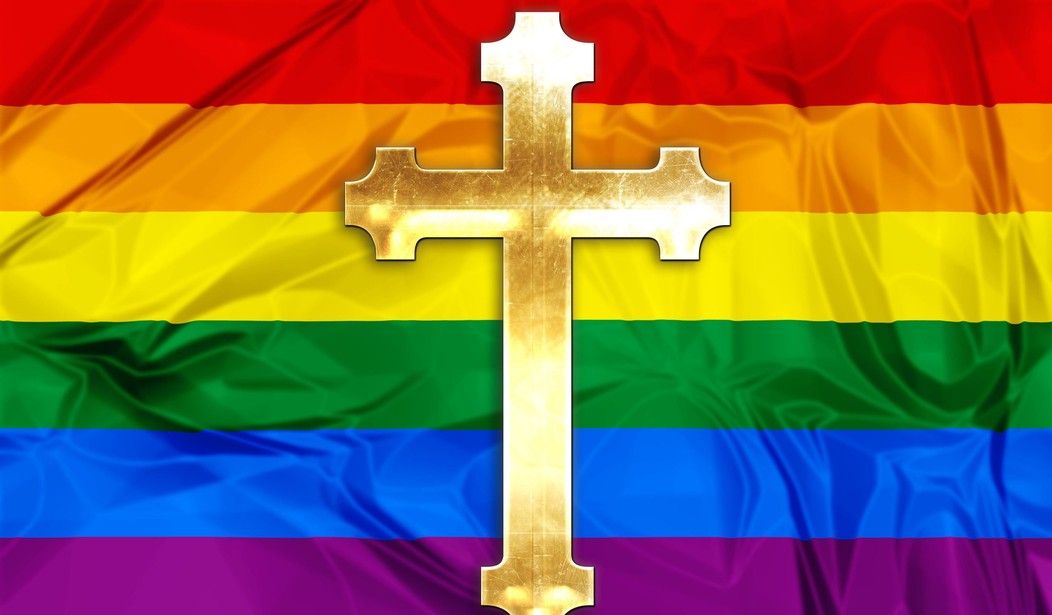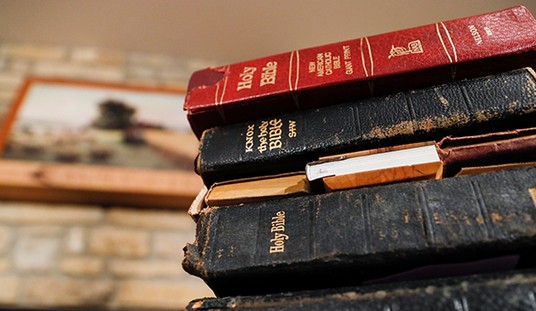Gay marriage is infiltrating evangelicals’ understanding of the Bible and how to live Christian lives in society. Many sophisticated theologians argue that marriage should be extended to same-sex couples, that the Bible does not forbid homosexual behavior, and that biblical notions of sex have been disproven by science.
“It is long past time that lesbian, gay, and bisexual Christians learn that there are Christian congregations who will welcome them as they are and that there are faithful Christians—pastors, theologians, church leaders— who are unashamedly Christian and unashamedly gay,” writes Megan K. DeFranza, a co-author of Two Views on Homosexuality, the Bible, and the Church. DeFranza argues that gay Christians “do not have to choose between their sexual identity and their Christian faith.”
She is not alone in this position. The book, published by Zondervan, features a dialogue between two positions: the “traditional” view which regards homosexual behavior and same-sex marriage as wrong, and the “affirming” view which finds a place for gay marriage inside the Christian church. Interestingly, the two scholars who argue for the traditional view agree on most points, while the “affirming” authors disagree with one another on how to interpret scripture.
In discussions about homosexuality and the church, Christians must wrestle with two kinds of Bible passages: those explicitly condemning homosexual behavior (called the “prohibition passages”) and those presenting marriage as between a man and a woman.
DeFranza takes an interesting approach to both. Contrary to most readings of the prohibition verses, she argues that scripture only condemns abusive same-sex behavior, not same-sex behavior in general.
“Just because the Bible declares some heterosexual sex as sinful does not mean that all heterosexual sex is sin,” DeFranza argues. “In the same way, just because the Bible condemns certain kinds of same-sex sexual acts does not mean that all same-sex sexual acts are therefore out of bounds.”
She points out that the story of Sodom and Gomorrah in Genesis 19 (and its parallel in Judges 19) depicts “gangs threatening to rape men and angels.” As such, the story warns about judgment upon sin, but teaches “nothing about marriage.”
Similarly, the prohibitions in 1 Corinthians 6 and 1 Timothy 1, which condemn “the effeminates,” “sodomites,” or “male prostitutes,” can be read as “proscriptions of decadence, lack of self-control, and exploitation, including the sexual exploitation of enslaved persons and prostitutes.”
Leviticus 18 and 20 clearly condemn homosexual behavior or “sleeping with a man as one beds a woman.” But DeFranza rightly argues that “not all of the Levitical commands are considered binding by Christians today.” She argues that the cultural gulf between ancient society, when “same-sex relations were understood to dishonor a man by treating him as a woman,” and today, when “sexual orientation” is better understood, should enable Christians to discard this command of the Old Law.
Finally, DeFranza addresses Romans 1, which she considers a “rhetorical ‘sting operation’ intended to stir up judgmental ire against ‘godless’ Gentiles which turns on those doing the judging, proving all need redemption in Christ.” This is, indeed, the purpose of the passage. The scholar argues that “the apostle could very well have had in mind the excesses of the Roman aristocracy and imperial court.”
Indeed, the Roman aristocracy at the time kept eunuchs, men, and woman as sexual slaves. The Emperor Gaius Caligula was even accused of incest with his sisters, sexual liaisons with wives of dinner guests, and more perversions. Finally, a military officer whom Caligula had sexually humiliated assassinated the emperor, and repeatedly stabbed him in the genitals. DeFranza explains St. Paul’s argument that homosexuals “received in themselves the due penalty for their error” as a possible reference to Caligula.
She also condemns the use of “nature” — Romans 1 condemns homosexual acts as “against nature” — as an argument due to “the fact that nature was also used to defend slavery (including sexual slavery), prostitution, and rape.”
This argument is interesting, because the general tendency of Christian teaching on slavery has been to oppose it (Christians abolished slavery in the 800s and the 1800s, and Roman Catholic scholars condemned the early Spanish Empire’s abuse of native Americans), save for a brief stint in the American South, when scholars adopted the tenuous argument that black people, as children of Ham, have a natural curse from Genesis.
Having addressed the prohibition passages, DeFranza moves on to argue for the extension of Christian marriage to same-sex couples. Here, she makes perhaps the most surprising argument of all — that when St. Paul said marriage is a symbol for Christ’s union with the church (Ephesians 5:32), he was not referring to marriage as it exists today, the “egalitarian marriage” where husband and wife are equal, but to “ancient patriarchal marriage,” in which the husband was considered superior to the wife.
“Patriarchal marriage, the union of an inferior person to one who is superior and to whom one owes obedience, is much more suited to illustrate the relationship of the church to Christ than contemporary heterosexual marriage,” DeFranza writes. “It is the imbalance of power between humanity and divinity that led ancient writers to see a parallel in the imbalance of power between wives and husbands which was assumed by them to be natural and secured by law.”
Indeed, most men in the ancient world married younger women, who were seen as less experienced and given fewer rights than men, partially for this reason.
Now, DeFranza does not argue for a return to imbalanced marriage. She admits that the modern view of marriage does indeed “better reflect biblical teaching about the value of all human life,” regardless of sex. But she also argues that the question of gay marriage is not whether to abandon biblical marriage but whether to revise it “yet again to better honor the humanity of gay, lesbian, and bisexual people.”
DeFranza makes the (rather tenuous) argument that Genesis 1 and 2, the passages about marriage being between one man and one woman, “can be understood as the majority story rather than the exclusive model for what it means to be human.”
Marriage can be extended to homosexual couples by removing the sex complementarity which Genesis states: “Burning with passion for a sexual partner, [homosexuals] yearn for the kind of union wherein they too can sanctify their desires, directing their energies toward the good of their spouse, wherein they too can model the faithfulness of God’s covenant love and know joy.”
William Loader, another author who argues for the “affirming” view, vehemently disagrees with DeFranza’s characterization of the prohibition passages. He argues that, in the context of first century Jewish writings, homosexuality was seen as unnatural — “God made people heterosexual, male or female, not homosexual.”
Loader explains the Leviticus passages as a condemnation of “inappropriate mixing,” and an assertion of divine will. Furthermore, Loader presents Romans 1 as a clear condemnation of homosexual desires, not just actions, as sinful and the result of sin.
Responding to DeFranza, Loader argues that “the problem is not primarily excess, but direction.” The Bible condemns homosexuality, and to ignore that would be to not take the Bible seriously.
But Loader doesn’t condemn homosexuality as sinful. Instead, he thinks the Bible needs to be updated. “Paul appears to assume, like other Jews whose discussions have survived, that all people are heterosexual,” the author writes. “A homosexual orientation is contrary to nature as God created people. Thus he treats such attraction psychologically. A perverted understanding of God results in a perverted mind now sexually attracted to its own gender.”
Rather than agreeing with St. Paul, Loader argues that “this is just one of many areas where it has been necessary to supplement first-century understandings of reality with twenty-first century understandings. To do so is not to show disrespect for biblical writers, but to stand alongside them in their commitment to truth and willingness to change as essential to their faith.”
In order to argue that Christians should accept the new “scientific” understanding of people as being born gay, Loader points to other areas of scientific knowledge lacking among biblical writers. “These include belief that the universe was only a few thousand years old… that there was a single original man, that woman was created from his rib, and that increased pain in childbirth and thorns and thistles came about because of Eve’s sin,” he argues. Similarly, Christians today reject the “belief in a three-tiered universe or in the earth as a sphere which the sun orbited.”
“Acknowledging that the universe is billions of years old, for instance, does not mean that we dismiss all the rest of Scripture,” Loader argues. “Similarly, acknowledging that human beings may be heterosexual and homosexual and not just male or female does not mean dismissing all the Bible says about humanity.”
Indeed, Loader has a point. He even fails to present it in the most compelling way. There are hundreds of examples from the Bible’s view of cosmology, biology, and other sciences that are less controversial to dismiss. While many Christians adopt a “young earth” view of the universe, no Christian today agrees with the statement that “the mustard seed is the smallest of seeds.” Nor do Christians still believe that the earth is a flat disk with the heavens above and hell below.
But Loader also assumes too much about modern science. The arguments for an old earth — or even for evolution — are more established scientifically than the argument that humans are born with a sexual orientation (homosexual or heterosexual). Indeed, Johns Hopkins University has released studies showing that there is “no evidence” people are born homosexual.
Even accepting Loader’s point that some people are born homosexual, it does not follow that the church must regard their relationships as equal to heterosexual marriages. Stephen R. Holmes, who supports the “traditional” side of the issue, notes that “ideas of the fall and original sin teach us that all our desires are in some sense wrongly directed.”
Holmes argues that St. Paul did not see Roman aristocrats who raped their slaves as “heterosexual,” but rather “Paul would have regarded both with equal horror as marks of disordered sexuality.” Scripture presents “an account of properly ordered sexuality that led to either celibacy or disciplined heterosexual monogamy,” and reasons to believe that any other type of sexuality is disordered.
“But every desire of every person is wrongly directed,” Holmes notes. “Marriage is a place where our wayward sexual desires are reordered (and, again, all of our sexual desires are wayward), not a place where we are permitted to indulge such wayward desires.”
Holmes reminds Christians that sexual sin is possible in heterosexual marriages, as well as homosexual relations, and that “any suggestions that to be gay (or intersex) is to be somehow ‘more fallen’ than being straight (or male or female) must be resisted strenuously—not just because it is oppressive but because it is bad theology.” Even heterosexual desires are naturally sinful, and straight people should not take a “holier-than-thou” attitude toward homosexuals.
Perhaps the most powerful arguments for the “traditional” view which condemns homosexual acts and same-sex marriage comes from Wesley Hill, a homosexual Christian who has dedicated himself to celibate relationships.
Hill accepts scripture’s consistent declaration of same-sex sexual activity as disordered, and he even dismisses the LGBT movement’s push for “gay identity.” “Once ‘gay identity’ has been established … it becomes difficult, for instance, to comprehend the gospel’s demand that all of our assumed identities be relativized in the light of the ‘new name’ (cf. Rev 2:17) given to each of us in baptism.” Indeed, “there is a more powerful sense in which Christians are no longer tethered to their previous identities: ‘It is no longer I who live, but it is Christ who lives in me.’ (Gal 2:20).”
Nevertheless, some kind of same-sex relationship is possible, and indeed can be considered a Christian vocation. Hill describes the “calling of spiritual friendship.” He notes, “I am learning to pursue deeper, more permanent sorts of bonds with friends of the same (and opposite) sex, all the while maintaining my commitment to sexual abstinence.”
Hill even argues that this kind of solemn friendship traces back through Christian tradition. “Throughout much of Christian history, in both the Christian East and West, friendship was capable of solemnization, celebrated with public recognition, and strengthened by mutual promissory bonds.” As an example, Hill mentions the twelfth century monk Aelred, arguing that it is probable this monk, “prior to his entrance into monastic life, was sexually involved with male partners.”
Holmes, the other defender of the “traditional” view, even went so far as to say that Christian churches can accept, in a limited way, gay and lesbian couples who were committed to one another (perhaps even raising children) before converting to Christianity.
Throughout Christian history, churches have made space for people living in various states of sin to nevertheless join the church. In some African churches, polygamous families were allowed to become Christian and remain together, since forcing them to break up would have left women and children destitute. “There was—is—no acceptance of polygamy, but a pastoral accommodation to the cultural and missional reality of that particular context,” Holmes explains.
In a similar way, Holmes says that married gays and lesbians should be welcomed into the church, because Jesus’ death and resurrection offers forgiveness for everyone. But “pastoral accommodation does not mean pretending ethical standards to not exist.”
Churches must maintain the purity of their witness, preaching the truths of the gospel and rejecting the popular notions that homosexual relationships are equal to heterosexual marriages. Nevertheless, they must preach redemption to all people, and insist that straight people are just as sinful as their homosexual counterparts.
Holmes puts the challenge well. Christians must maintain their fidelity to scripture’s moral commands while also extending love and forgiveness to everyone.
“I cannot imagine a conservative church practice that is adequately loving to LGBT+ people;” “I cannot imagine an affirming church practice that takes the call to holiness adequately seriously.”
To this, Holmes argues, “We are called to go beyond our imaginations, to be led by God’s Spirit into church practices that are as welcoming of outcasts as Jesus was during his earthly ministry and as implacable in the face of sin as Jesus was then.”
Amen. The pressure to accept homosexuality and gay marriage must be resisted, but the love and compassion which often inspires it should not be rejected. Ultimately, none of us will be as holy as Jesus, the one man who could love the sinner so much as die on the cross, while also hating the sin with the righteous wrath reserved to God alone.









Join the conversation as a VIP Member